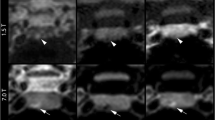Abstract
Cushing’s disease manifests as symptoms of glucocorticoid excess secondary to the increased secretion of corticotropin by a corticotroph adenoma in the pituitary gland. Unfortunately, magnetic resonance imaging (MRI) performed at conventional clinical field strengths of 1.5 or 3 Tesla has limited sensitivity for the detection of these pituitary tumors, and radiologic uncertainty often necessitates more invasive workup to confirm diagnosis and guide resection. It has been postulated that higher static magnetic field strengths may increase the adenoma detection rate and thus the utility of MRI for this clinical application. In this report, we describe our initial experience using ultra-high field 7 Tesla (7 T) MRI in patients with suspected Cushing’s disease and negative or equivocal imaging at conventional field strengths. We performed contrast-enhanced 7 T pituitary MRI in 10 patients with up to three different T1-weighted sequences and correlated the imaging abnormalities identified with results of histologic evaluation in patients who subsequently underwent resection. We found that 7 T MRI enabled the identification of previously undetected areas of focal pituitary hypoenhancement in 9 patients (90%), of which 7 corresponded histologically to corticotroph adenomas. These early findings suggest an important adjunctive role for ultra-high field MR imaging in the noninvasive clinical workup of suspected Cushing’s disease.

Similar content being viewed by others
References
Newell-Price J, Bertagna X, Grossman AB, Nieman LK (2006) Cushing's syndrome. Lancet 367:1605–1617. https://doi.org/10.1016/S0140-6736(06)68699-6
Deipolyi A, Karaosmanoğlu A, Habito C, Brannan S, Wicky S, Hirsch J, Oklu R (2012) The role of bilateral inferior petrosal sinus sampling in the diagnostic evaluation of Cushing syndrome. Diagn Interv Radiol 18:132–138. https://doi.org/10.4261/1305-3825.DIR.4279-11.0
Trattnig S, Springer E, Bogner W, Hangel G, Strasser B, Dymerska B, Cardoso PL, Robinson SD (2018) Key clinical benefits of neuroimaging at 7T. Neuroimage 168:477–489. https://doi.org/10.1016/j.neuroimage.2016.11.031
Law M, Wang R, Liu CJ et al (2018) Value of pituitary gland MRI at 7 T in Cushing’s disease and relationship to inferior petrosal sinus sampling: case report. J Neurosurg 130:347–351. https://doi.org/10.3171/2017.9.JNS171969
Nieman LK, Biller BM, Findling J, Newell-Price J, Savage MO, Stewart PM, Montori VM (2008) The diagnosis of Cushing’s syndrome: an Endocrine Society clinical practice guideline. J Clin Endocrinol Metab 93:1526–1540. https://doi.org/10.1210/jc.2008-0125
Padormo F, Beqiri A, Hajnal JV, Malik SJ (2016) Parallel transmission for ultrahigh-field imaging. NMR Biomed 29:1145–1161. https://doi.org/10.1002/nbm.3313
Funding
This research did not receive any specific grant from funding agencies in the public, commercial, or not-for-profit sectors.
Author information
Authors and Affiliations
Corresponding author
Ethics declarations
Conflict of interest
The authors declare that they have no conflict of interest.
Ethical approval
All procedures performed in studies involving human participants were in accordance with the ethical standards of the institutional and/or national research committee and with the 1964 Helsinki Declaration and its later amendments or comparable ethical standards.
Informed consent
Informed consent was obtained from all individual participants included in the study.
Additional information
Publisher’s note
Springer Nature remains neutral with regard to jurisdictional claims in published maps and institutional affiliations.
Rights and permissions
About this article
Cite this article
Patel, V., Liu, CS.J., Shiroishi, M.S. et al. Ultra-high field magnetic resonance imaging for localization of corticotropin-secreting pituitary adenomas. Neuroradiology 62, 1051–1054 (2020). https://doi.org/10.1007/s00234-020-02431-x
Received:
Accepted:
Published:
Issue Date:
DOI: https://doi.org/10.1007/s00234-020-02431-x




